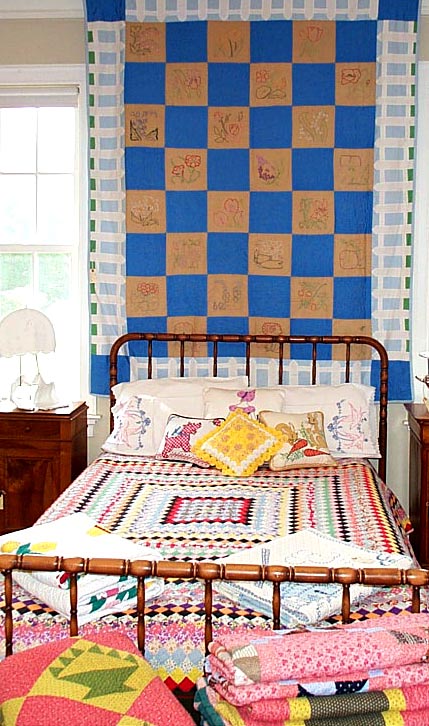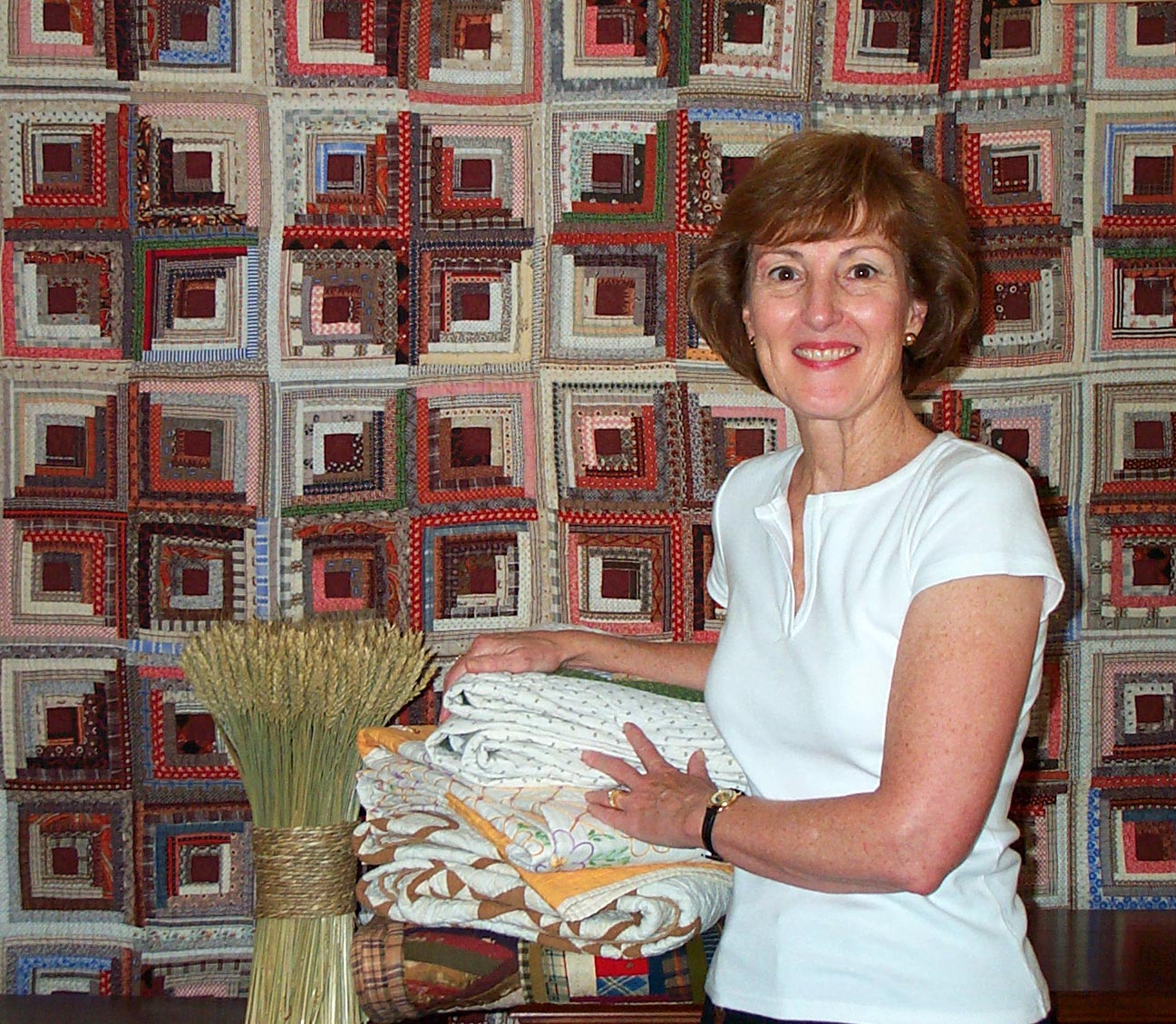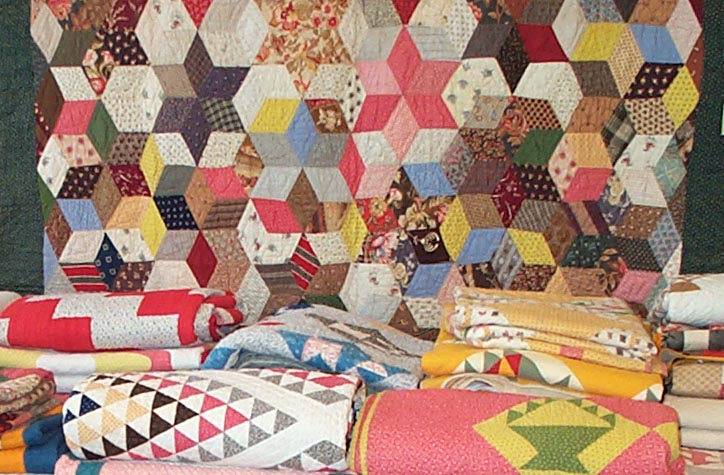|
1) How do you prefer to be described as, within the field of
textile history?
If you have a business, please tell us
about that.
"Probably
'avid collector' is the best way to portray myself (although some would
say 'quilt nut' is a more apt description).
"I've been simply crazy about antique quilts for decades so after my
retirement as a marketing consultant in 1997, I founded Kirkwood Quilts. This
second career path permits me to share my love of these treasured textiles with
others. Today, I travel the blue highways of the country seeking outstanding
examples of this typically American art form. I buy from and sell to other
collectors of fine antique quilts,
 speak to local organizations, and work with
interior decorators to help them incorporate these wonderful examples of
American folk art into the home and office décor of their clients." speak to local organizations, and work with
interior decorators to help them incorporate these wonderful examples of
American folk art into the home and office décor of their clients."
2) When and
where did you begin your serious interest in the history of quilts,
textiles or garments?
"Before I go any further I need
to make a confession. I've been having a love affair for more than 25
years … and my husband doesn't mind a bit. That's because I'm not
obsessed with another man … it's antique and vintage quilts I lust
after!!
"My appreciation of quilts dates to 1976. If you remember, this is when
dark oak paneling was considered chic. Well, I had a family room with this dark
paneling and I was looking for a decorative quick fix to brighten it up. While
attending a local flea market, I saw some interesting fabric peeking out of a
box in the back of one booth. I was infatuated. Upon closer inspection, I
discovered that it was a funky c. 1940 pinwheel pattern quilt and something
about it spoke to me. My heart skipped a beat.
"After I hemmed and hawed with the vendor for a few minutes, he finally
agreed to accept the $35 I had to offer (which was all the money I had in my
purse at the time). I rushed home with my treasure, threw it over the back of
the couch and marveled as its wonderful graphics and quirky composition
instantly brought warmth and life to that room.
"Voila. I no longer focused on the dark paneling on the four walls.
Instead, I saw a lively pattern … I saw a textile that spoke of comfort …
and when I looked closely, I could almost see the loving hands of the maker. And
that's when I fell in love!
"Since then I've added hundreds of quilts to my collection, all of which
have been more expensive, more skillfully made and certainly in better condition
… but this rather homely textile continues to hold my heart because it was my
first love.
"When you love something … whether the object of your affection is a
person, an object or a topic … you want to know all you can about it. And so
it has been with me. Over the years, as my love and appreciation of antique
quilts has grown I have tried to learn as much as I can about them, including
their history. Not only does this enhance my enjoyment of quilts, it also allows
me to educate others about their place in our country's past."
3) What
“known” individual or group influenced you most and why?
"Two prominent women in the
world of antique American quilts have had an enormous influence on me:
Phyllis George (the former Miss America and first lady of Kentucky)
sparked my interest in quilts as decorative accessories and Barbara
Brackman (one of the leading authorities on the history of American
quilts) challenged me to appreciate their historical perspective.
"Early on as I added to my collection, I realized that each and every
quilt has a story. But unfortunately, because very few were ever signed or
dated, for the most part these stories have been lost. I wanted to know more
about each quilt … and its maker … but didn't know where to begin to unravel
the mystery. Barbara's book, Clues In The Calico, has served as my
"bible" for years as I have improved my skills as a "quilt
detective."
"After reading Phyllis George's book, Living With Quilts, I
realized that quilts could do more than cover a bed. They could become the focal
point of a room's décor or one of the decorative accents used to perk up a room
(such as my dark paneled family room). She also taught me that quilts don't have
to mean "country" when it comes to decorating. They can be
successfully displayed in sophisticated condos, contemporary lofts, fashionable
beach cottages, and even exquisite villas on the French Riviera. I tell people
to flip through the pages of Architectural Digest if they don't believe me.
"Both of these women opened my eyes to the fact that quilt-making in
America involves more than pattern and fabric. It weaves together social
history, folk art and women's issues in a most interesting way. And I have tried
to convey these aspects as I speak with various groups in my area."
4) Who
became your personal mentor as you began your learning?
"After my retirement in 1997, as I was noodling with the idea of
starting Kirkwood Quilts, I had the very good fortune to meet Merikay
Waldvogel. She generously shared with me her experiences in the antique
quilt world and encouraged me to "follow my bliss."
 She also
introduced me to AQSG and the QHL, both of which have been invaluable
resources along my path. So thank you, Merikay. I haven't told you nearly
often enough how grateful I am to you for pointing me in the right
direction." She also
introduced me to AQSG and the QHL, both of which have been invaluable
resources along my path. So thank you, Merikay. I haven't told you nearly
often enough how grateful I am to you for pointing me in the right
direction."
5) What
aspect of study were you most passionate about at first?
How has this changed over time and why?
"Initially my focus was the
fact that, as decorative accessories, quilts seemed to be
under-appreciated. And I thought that was a shame since they have
exceptional decorative clout. From colonial to cutting edge contemporary,
any interior can be more welcoming and more beautiful with the addition of
a great American quilt.
"As my love of heirloom quits deepened, my appreciation has grown beyond
their decorative value. While my joy continues to be helping someone display an
antique quilt, my satisfaction grows when I can also put that quilt into a
historical perspective, dispel popular misconceptions and provide accurate and
useful information about their care."
6) What is
your current “pet project”?
"I consider it a personal mission
to encourage every client, every audience member, everyone I know who owns
antique quilts to construct a "quilt memoir" of any quilt in their
possession. I point out that in the past most antique quilts were not signed
or dated, since they were considered simply household textiles and not
pieces of art. That means we rarely know the names of their makers and don't
even know where to begin to recreate their stories. However, I believe that
this is a problem that does not need to be perpetuated.
"That's why I encourage quilt owners to write down everything they know
about their quilt(s) and the maker(s) and to take photo(s) of the quilt(s). I
suggest they put the "memoir" and the photos in an envelope, which
they can pin to the back of the quilt. Or I recommend making a muslin label with
all the pertinent information and sewing it to the back of the quilt. Either
way, the quilt and the information won't become separated over time. And finally
I point out that the investment of time and effort needed to prepare the
"memoir" will pay huge dividends in the future through the gratitude
and appreciation of any future owners of the quilt."
7) What
aspect of your research or contribution to textile studies has satisfied
you the most?
"One of the most satisfying aspects of
my public speaking and trunk shows has been learning that certain audience
members have benefited from my remarks. I have had people call to say that
they were motivated after my talk to go home and get grandma's quilt out
of the box under the bed and display it. Others have said that my
suggestions for cleaning an antique or vintage quilt have been very useful
(and successful). And yet others have told me that they had not considered
quilts to be artistic objects, but after hearing me decided to buy an
antique quilt as a way to own a piece of American folk art."
8) Within
the textile arena, what would you like to do, but haven’t done yet?
"I have several book ideas that I think about from time to time. I would
like to visit some of the Western states (Montana, Utah, Idaho) to learn more
about their quilt traditions. I'd love to take more classes at the American Folk
Art Museum. And I think it would be fun to develop a fabric line based on some
of the quilts in my collection. Mostly I remember the phrase, "So many
quilts, so little time," and realize that during my lifetime I will
probably never complete all the quilt related projects I'd like to accomplish.
And maybe that's all right, since it means this love affair I'm having is still
going strong."
9) Any further comments are invited.
"Thank you so much for including me in your interview section. It is
truly a pleasure and a privilege to be included with such magnificent scholars -
for whom I have the utmost respect - and to share my love affair with antique
and vintage quilts in this way."
Please describe (in a list) the contributions you have made via books,
exhibits, presentations, contests, articles, fabric lines, research papers
and the like.
PRESENTATIONS:
Crazy About Quilts
A 45-minute presentation (complete with quilts) delivered to local quilt guilds.
Decorating With Antique Quilts
A 30-minute talk given at area Country Curtain stores.
Heirloom Quilts: Decorative accessories with heart
A 45-minute trunk show presented to local women's groups.
Living With Heirloom Quilts
A 30-minute presentation given to American Association of University Women.
The ABCs of Antique Quilts
Presentation to Friendship Star Quilt Guild focusing on the Appreciation, Buying
and Caring for heirloom quilts.
EXHIBITS:
A Celebration of Traditional Arts
Norwalk, CT
Stamford, CT
A Celebration of American Arts
Lincoln, MA
Weston, CT
Wilton, CT
Thank you very much for sharing your self with us today, and for the insights
we have gained because of your efforts as a collector of quilts. Continued
success to you.
|